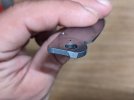Despite such a fiery and impassioned post when I received my less-than-perfect Small Seb 31 (I was quite disappointed), I changed my mind on returning the knife and decided to give it a try. I started carrying the small sebenza 31 regularly, and tried to ignore the lock flex as much as possible.
After several weeks of use, the lock flex remains but has improved markedly. Perhaps the suggestion of a break-in period is valid. Most importantly, the lock flex is completely imperceptible in normal use. It turns out I love this knife so much for all of its others qualities that I hardly care. As well, it gives me a reason not to fuss over imperfections from use.


